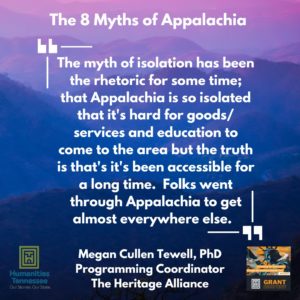Cultural Sector Pandemic Recovery
When Congress passed the American Rescue Plan in March 2021, the goal was imbedded in the name. For Tennessee cultural organizations, having to close the doors for nearly two years resulted in lost revenue and jobs, uncertainty, and disconnection. What would it look like if some of our most vital community organizations no longer existed? From the Heritage Alliance in northeast Tennessee to RISE Chattanooga, Cumberland River Compact and Wolf Gap in Middle TN, and Paris County Heritage Center and The Griot Collective of West Tennessee, just to name a few…who might we be without the work of these organizations in our communities? As much as the pandemic forced us to ponder that question, it also pushed us to collaborate on solutions.
In many ways, 2022 offered the first steps toward pandemic recovery and a glimpse of future opportunities. In January 2022, Humanities Tennessee awarded $941,454 of Congressionally appropriated funds to 91 organizations across the state to support their recovery and sustain future operations. The Sustaining the Humanities through the American Rescue Plan (SHARP) funds were immediately put to use saving jobs, operating historical buildings, bringing programs to the community, and connecting people virtually and in-person.
Since June, we have shared spotlights on the work of these organizations and their local impact. We encourage you to visit our blog to catch up on those stories.
The most notable impacts shared by organizations across the state include the retention of cultural sector jobs, new partnerships, increased community involvement, financial recovery, and new opportunities to build on in the future. In short, organizations are able to continue their work and have found even better ways to have a collective impact. Here are just three examples:
- International Storytelling Center (Jonesborough)

The International Storytelling Center was able to hold the 50th National Storytelling Festival in Jonesborough, Tennessee for the first time since 2019. This funding allowed us to revive a one-of-a-kind cultural event that connects people from rural areas throughout Northeast Tennessee with powerful storytelling performances representing traditions from across the globe. Our community desperately needed this event, and the multi-million-dollar tourism impact it brings to our area, as a vital part of our economic and cultural recovery from the pandemic.
- Heritage Alliance (Jonesborough)

We were able to keep our Programming Coordinator on staff. Without a Programming Coordinator, we would not be able to host the Taste of Tennessee festival this year. Keeping our Programming Coordinator on staff meant we had new programs in the fall, including a circus themed night at the Jonesborough/Washington County History Museum. It meant that one of our museum cases is now on its way to becoming an interactive case. Museum goers will be able to open the drawers and find additional artifacts that pertain to the exhibit on display. This will be a great tool for school groups.
Keeping our Programming Coordinator also meant that we had an extra, much needed hand to assist with Christmas activities at the Chester Inn Sate Historic Site and Museum. These programs are all free and help grow our audience base and share history with more people.
During this time, our Program Coordinated created a new exhibit called 8 Myths of Appalachia. This exhibit includes special programs of its own, including a study guide. It will help to share the diverse history of Appalachia and tell the stories of individuals in this region who are often left out of the national narrative. None of this work would have been possible without our Programming Coordinator.
- Museum of Science and History (MoSH, Memphis)
MoSH exhibit “Savages & Princesses: The Persistence of Native American Stereotypes” featured the visual art of 12 contemporary Native Americans for the purpose of questioning and challenging stereotypes. MoSH’s Community Engagement staff interacted with 1,035 visitors during the exhibit’s run, including 781 school group visitors. Instructors engaged with students from four elementary schools, seven middle schools, and one high school, representing Shelby and Obion counties in TN, DeSoto County, MS, and Crittenden County, AR.

Instructors set up ‘touch carts’ to engage with visitors, encouraging them to think more deeply about the stereotypes portrayed by the artists. For example, Tony Corti, the actor known as the ‘Crying Indian’ in the Keep America Beautiful anti-litter ad campaign of the 1970s, was actually of Sicilian heritage, claiming multiple Native American tribes throughout his life. Other stereotypes explored by MoSH staff included how sports teams use the images of Native Americans, as well as products like chewing tobacco/cigar stores, Eskimo Pies, etc. In addition to stereotypes, another touch cart examined the differences in maps designed by Europeans versus Native Americans, exploring how European settlers used maps to override the Native Americans already living on land they wished to claim.
What’s Next?
The story of Tennessee’s cultural sector pandemic recovery doesn’t end here. It is just beginning.
As we turn the page to 2023, we hope you’ll continue to visit our blog, newsletter updates, and social media channels and those of the SHARP grantees. Humanities Tennessee and the 91 SHARP-funded cultural organizations are poised to build on this momentum so that we may experience a future in which Tennesseans seek knowledge, share stories, and unite with empathy to create stronger communities.


